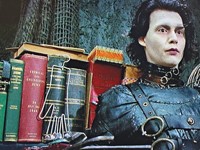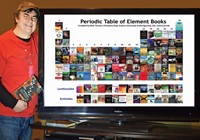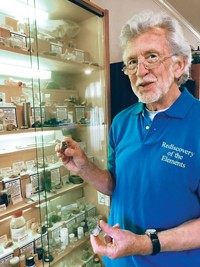Advertisement
Grab your lab coat. Let's get started
Welcome!
Welcome!
Create an account below to get 6 C&EN articles per month, receive newsletters and more - all free.
It seems this is your first time logging in online. Please enter the following information to continue.
As an ACS member you automatically get access to this site. All we need is few more details to create your reading experience.
Not you? Sign in with a different account.
Not you? Sign in with a different account.
ERROR 1
ERROR 1
ERROR 2
ERROR 2
ERROR 2
ERROR 2
ERROR 2
Password and Confirm password must match.
If you have an ACS member number, please enter it here so we can link this account to your membership. (optional)
ERROR 2
ACS values your privacy. By submitting your information, you are gaining access to C&EN and subscribing to our weekly newsletter. We use the information you provide to make your reading experience better, and we will never sell your data to third party members.
Education
To share a love of chemistry, it helps to have a ton of stunning photos
Theodore Gray talks about his series of chemistry books and their companion apps
by Bethany Halford
November 27, 2017
| A version of this story appeared in
Volume 95, Issue 47

As Theodore Gray tells it, his journey to becoming one of chemistry’s most visible communicators—as the author of half a dozen popular chemistry books and the creator of a couple of chemistry-related iPad apps—began with a miscommunication. Or, to be more precise, a misreading of Oliver Sacks’s “Uncle Tungsten: Memories of a Chemical Boyhood,” in which Sacks describes a periodic table at the Science Museum in South Kensington, England, that contains cubicles for 90 element samples. Gray thought Sacks was describing an actual table rather than the wall-mounted cabinet that housed the museum’s element collection.
Vitals
Hometown: Urbana, Ill.
Education: B.S., chemistry, University of Illinois, Urbana-Champaign.
Notable awards: 2002 Ig Nobel Prize in Chemistry; 2011 ACS James T. Grady-James H. Stack Award for Interpreting Chemistry for the Public; 2014 British Academy of Film & Television Arts Award in the Children’s Interactive category for the Disney Animated app
Books: “The Elements,” “Molecules,” “Reactions,” “Theo Gray’s Mad Science,” “Mad Science 2,” “Theodore Gray’s Completely Mad Science” (which he describes as a collection of the first two books plus a little extra)
Favorite chemical reaction: Sodium in water
Favorite book: “Uncle Tungsten: Memories of a Chemical Boyhood” by Oliver Sacks
Number of objects in his element collection: Approximately 3,000
Favorite object in element collection: Undecided. “I don’t have a favorite child either.”
When Gray realized his error and that there was no table shaped like the periodic table, he decided to create one. The “periodic table table” he crafted—complete with cubicles for element samples from Gray’s personal collection—earned him the Improbable Research 2002 Ig Nobel Prize in Chemistry and caught the eye of Popular Science’s editor, who asked him to write a monthly column for the magazine.
C&EN first talked with Gray 10 years ago, when he had just published periodictable.com—a periodic table website that catalogs the samples of his vast element collection with splendid photographs. Some of those same photos grace a periodic table poster Gray sells on his website.
“It occurred to me that I had all these pictures,” Gray remembers. “I felt like I could come up with a few hundred words about each element, so I thought I should write a book.” And that is how “The Elements: A Visual Exploration of Every Known Atom in the Universe” came about.
Gray was pleased with the book, but he knew the paper text was limited by its static nature. After all, he and photographer Nick Mann had created rotating video loops of many of the objects in Gray’s element collection, each compiled from 360 high-resolution photos taken at 1° increments around the samples. You could virtually spin the objects on Gray’s website, but those entries didn’t match up with his vision.
“I wanted something that had the same beautifully composed pages and the same text as the book but you could spin everything,” he says. When the book came out in 2009 there was no platform for doing that, though, says Gray, who is also a software engineer. “You couldn’t sell it as a piece of software,” he says. “You couldn’t really do it as a website because you couldn’t make any money. It was just too much work to do for free. It only made sense as an app, but iPhones were way too small” to truly appreciate the photos of the elements.
Then, on Jan. 27, 2010, Apple’s Steve Jobs announced the company would start selling the iPad. “I remember thinking the instant I saw the iPad, ‘That’s the device.’ It was like it was created to be the platform on which I could make an Elements app,” Gray recalls.
“There was this two-month window in which the existence of the iPad was known but nobody had one,” Gray says. But Gray did have one. Or, at least the software company he cofounded, Wolfram, had one. “In a broom closet that we’d cleaned out, chained to a giant, iron ball, was a prototype iPad,” Gray remembers. It was one of only 50 that were sent out to potential app developers.
“I was supposed to be doing a Wolfram-related app, which we did do, but I thought this is an opportunity to do something unexpected and interesting,” Gray says. “So I dropped everything, and I called my friend Max Whitby in England, who I had worked with before and who had done app development with his partner John Cromie.”
The three put together The Elements app, and Apple promoted it heavily, loading it onto iPads given to journalists to review. “That did more for print book sales than anything else,” Gray points out.
While the comprehensiveness of “The Elements” was satisfying, Gray says he soon realized it should be part of a trilogy of books. “Molecules: The Elements and the Architecture of Everything,” his second in the series, was published in 2014, and the final book, “Reactions: An Illustrated Exploration of Elements, Molecules, and Change in the Universe,” came out last month.
He saw the three books as the logical way to cover chemistry as a whole. “Obviously you start with elements because everything starts with elements, and when you connect elements with chemical bonds you get molecules, and then if you start throwing molecules at each other you get reactions.”
Gray notes that five years passed between the publication of “The Elements” and “Molecules,” in part because he had to decide what to include. Although he wrote about every element, he says, it would be a fool’s errand to try to do the same for every molecule or even every class of molecule. “It can’t even be done in a 500-page, densely written textbook, let alone in a book that’s 50,000 words with a lot of pictures,” he says. So Gray decided to focus on what he found interesting. The same was true for “Reactions,” he says. “Anybody who comes to these books expecting textbooks will be disappointed. But if you come just looking for something interesting, hopefully you’ll like it.”
Take, for example, the fifth chapter in “Reactions,” titled “The Boring Chapter.” Here Gray writes about the chemistry that goes on when paint dries, grass grows, and water boils. “They’re anything but boring if you look at them from the point of view of the molecular scale,” Gray says.
“ ‘The Elements’ and ‘Molecules’ were both books about stuff. They are, in a sense, nouns,” Gray points out. “But ‘Reactions’ is verbs. These are the action words of chemistry. It’s where stuff happens.”
One would think this would make “Reactions” ideal for an app. After all, The Elements app continues to sell, and the companion Molecules app was named one of the best apps of 2014 by Apple. But Gray says that because of the way the app market has changed, a Reactions app is unlikely. People just don’t want to spend $13 on an app anymore, and recouping the investment it would take to create such a sophisticated app would be difficult. Gray left Touch Press, the app development company he founded, and the company changed direction and name (although the Touch Press name lives on because the name was bought by another app development company).
Gray credits photographer Mann for the three books’ aesthetics. “My job tends to be to take whatever Theo puts in front of me and figure out how to make it beautiful,” says Mann, who was a teenager when he started working with Gray. “You see the photography, but a lot of what I spend my time doing is engineering.” For example, he says, it can take 45 minutes to set up the lighting for a particular shot. He notes that he tested at least a dozen different kinds of black paint for backdrops before settling on two that worked best.
One especially challenging sequence of photos from “Reactions” shows the sparking and smoky reaction that occurs when aluminum foil is dropped into bromine and aluminum bromide forms. “We needed a fume hood in the middle of a photography studio to actually get that shot,” he says.
The books’ stunning visuals are part of what draws in so many readers. And although Gray says he intended the books for people without expertise in chemistry, it’s still popular with chemists. “Chemists appreciate the fact that it helps them explain to other people why chemistry is interesting,” he says.
Gray says he’s particularly surprised by how many young people enjoy the books. Most of the emails he receives are from kids who are eight, nine, and 10 years old. “I think that’s the age at which kids become really enthusiastic and focused on something. For some of them it’s dinosaurs—they’ll memorize every dinosaur and tell you facts about them,” Gray says. “Some of them, who knows why, happen to get interested in elements. It’s like the natural world’s equivalent of Pokémon. You can learn all of them. You can complete your knowledge on the subject by being able to recite a fact or two about every element.”
Although Gray says he wrote his books for adults, they’re still quite accessible for kids. “They don’t talk down to them. They’re not written in the condescending style that one sees so often and is really off-putting to kids, especially smart kids.”
Gray says he tried not to let the popularity of “The Elements” with children influence how he put “Molecules” and “Reactions” together. “I didn’t want to end up writing a children’s book.” He points out that “Molecules” has a chapter on painkillers. He says that in deference to Scholastic, which distributes the book through in-school book fairs, he took out a two-page spread on bongs and marijuana buds. “But there’s a rock of crack cocaine in that book,” Gray notes. “We should talk about these things for what they are—they’re chemicals and they have these properties, and sometimes that goes well, and sometimes it goes badly.”
Gray says “Reactions” completes his set of chemistry books, but he doesn’t think this marks an end to his chemistry-related projects. He’s just waiting for inspiration about where to go next.





Join the conversation
Contact the reporter
Submit a Letter to the Editor for publication
Engage with us on Twitter